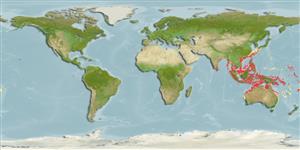Environment: milieu / climate zone / depth range / distribution range
Ecología
marino demersal; rango de profundidad 65 - 122 m (Ref. 9792). Tropical
Indo-West Pacific: Myanmar and Indonesia. Also from China Main (Ref. 31075), Hong Kong (Ref. 33837), and the Philippines (Ref. 9494).
Tamaño / Peso / Age
Maturity: Lm ? range ? - ? cm
Max length : 11.5 cm TL macho / no sexado; (Ref. 9792)
Radios blandos dorsales (total) : 68 - 72; Radios blandos anales: 55 - 57; Vértebra: 39. Head length 4.4 to 4.7 times in SL (Ref 12933).
Feeds on small benthic animals (Ref. 9792).
Life cycle and mating behavior
Maturities | Reproducción | Spawnings | Egg(s) | Fecundities | Larva
Gloerfelt-Tarp, T. and P.J. Kailola, 1984. Trawled fishes of southern Indonesia and northwestern Australia. Australian Development Assistance Bureau, Australia, Directorate General of Fishes, Indonesia, and German Agency for Technical Cooperation, Federal Republic of Germany. 407 p. (Ref. 5978)
IUCN Red List Status (Ref. 130435)
Threat to humans
Harmless
Human uses
Pesquerías: sin interés
Herramientas
Special reports
Download XML
Fuentes de Internet
Estimates based on models
Preferred temperature (Ref.
123201): 21.3 - 27.5, mean 25.2 °C (based on 211 cells).
Phylogenetic diversity index (Ref.
82804): PD
50 = 0.5000 [Uniqueness, from 0.5 = low to 2.0 = high].
Bayesian length-weight: a=0.01622 (0.00604 - 0.04358), b=2.94 (2.71 - 3.17), in cm total length, based on LWR estimates for this (Sub)family-body shape (Ref.
93245).
Nivel trófico (Ref.
69278): 3.5 ±0.37 se; based on food items.
Fishing Vulnerability (Ref.
59153): Low vulnerability (10 of 100).
